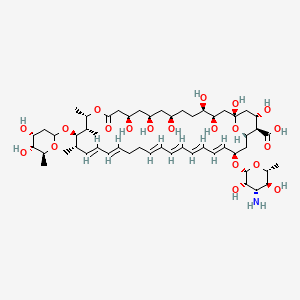| MeSH term | MeSH ID | Detail |
|---|---|---|
| Hemolysis | D006461 | 131 associated lipids |
| HIV Seropositivity | D006679 | 15 associated lipids |
| Hypertension | D006973 | 115 associated lipids |
| Influenza, Human | D007251 | 11 associated lipids |
| Leishmaniasis | D007896 | 19 associated lipids |
| Mycoses | D009181 | 18 associated lipids |
| Otitis Externa | D010032 | 8 associated lipids |
| Peritonitis | D010538 | 38 associated lipids |
| Pregnancy Complications, Infectious | D011251 | 11 associated lipids |
| Urethritis | D014526 | 9 associated lipids |
Nystatin A3
Nystatin A3 is a lipid of Polyketides (PK) class. Nystatin a3 is associated with abnormalities such as Mycoses, Candidiasis of the genitals and Gigantism. The involved functions are known as Drug Interactions, Process, Synthesis, Fermentation and Anabolism. Nystatin a3 often locates in Cell membrane, Membrane, Protoplasm, Entire oral cavity and integral to membrane. The associated genes with Nystatin A3 are Gene Clusters. The related lipids are Sterols, 1,2-oleoylphosphatidylcholine, Membrane Lipids, DOPE and N-caproylsphingosine.
Cross Reference
Introduction
To understand associated biological information of Nystatin A3, we collected biological information of abnormalities, associated pathways, cellular/molecular locations, biological functions, related genes/proteins, lipids and common seen animal/experimental models with organized paragraphs from literatures.
What diseases are associated with Nystatin A3?
Nystatin A3 is suspected in Mycoses, Candidiasis of the genitals, Gigantism and other diseases in descending order of the highest number of associated sentences.
Related references are mostly published in these journals:
| Disease | Cross reference | Weighted score | Related literature |
|---|
Possible diseases from mapped MeSH terms on references
We collected disease MeSH terms mapped to the references associated with Nystatin A3
PubChem Associated disorders and diseases
What pathways are associated with Nystatin A3
There are no associated biomedical information in the current reference collection.
PubChem Biomolecular Interactions and Pathways
Link to PubChem Biomolecular Interactions and PathwaysWhat cellular locations are associated with Nystatin A3?
Visualization in cellular structure
Associated locations are in red color. Not associated locations are in black.
Related references are published most in these journals:
| Location | Cross reference | Weighted score | Related literatures |
|---|
What functions are associated with Nystatin A3?
Related references are published most in these journals:
| Function | Cross reference | Weighted score | Related literatures |
|---|
What lipids are associated with Nystatin A3?
Related references are published most in these journals:
| Lipid concept | Cross reference | Weighted score | Related literatures |
|---|
What genes are associated with Nystatin A3?
Related references are published most in these journals:
| Gene | Cross reference | Weighted score | Related literatures |
|---|
What common seen animal models are associated with Nystatin A3?
There are no associated biomedical information in the current reference collection.
NCBI Entrez Crosslinks
All references with Nystatin A3
Download all related citations| Authors | Title | Published | Journal | PubMed Link |
|---|---|---|---|---|
| Darisipudi MN et al. | Polyene macrolide antifungal drugs trigger interleukin-1β secretion by activating the NLRP3 inflammasome. | 2011 | PLoS ONE | pmid:21625424 |
| Schulzke JD et al. | Anti-diarrheal mechanism of the traditional remedy Uzara via reduction of active chloride secretion. | 2011 | PLoS ONE | pmid:21479205 |
| Kalema N et al. | Oral antimicrobial rinse to reduce mycobacterial culture contamination among tuberculosis suspects in Uganda: a prospective study. | 2012 | PLoS ONE | pmid:22808020 |
| ZemljiÄ Jokhadar Å et al. | Osmotic Effects Induced by Pore-Forming Agent Nystatin: From Lipid Vesicles to the Cell. | 2016 | PLoS ONE | pmid:27788169 |
| Salyer AC et al. | Identification of Adjuvantic Activity of Amphotericin B in a Novel, Multiplexed, Poly-TLR/NLR High-Throughput Screen. | 2016 | PLoS ONE | pmid:26919709 |
| Ono J et al. | Widespread Genetic Incompatibilities between First-Step Mutations during Parallel Adaptation of Saccharomyces cerevisiae to a Common Environment. | 2017 | PLoS Biol. | pmid:28114370 |
| Boyce ST and Holder IA | Selection of topical antimicrobial agents for cultured skin for burns by combined assessment of cellular cytotoxicity and antimicrobial activity. | 1993 | Plast. Reconstr. Surg. | pmid:8341750 |
| Margineanu C et al. | [The anticandida action of the saponine from Primula (author's transl)]. | 1976 | Planta Med. | pmid:785496 |
| Gubler F et al. | Gibberellin signaling in barley aleurone cells. Control of SLN1 and GAMYB expression. | 2002 | Plant Physiol. | pmid:12011350 |
| Sertié JA et al. | Pharmacological assay of Cordia verbenacea V: oral and topical anti-inflammatory activity, analgesic effect and fetus toxicity of a crude leaf extract. | 2005 | Phytomedicine | pmid:15957367 |
